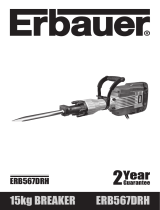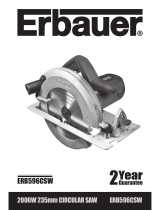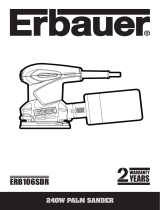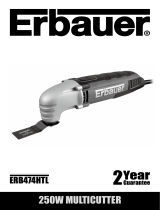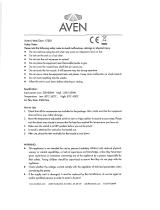Page is loading ...

2000W HEAT GUN
ERB096HTG
WARRANTY
YEARS


2000W HEAT GUN
GUARANTEE
This
product carries a guarantee of 24 months. If your product develops a
fault within this period, you should in the first instance contact the retailer where the
item was purchased.
This guarantee specifically excludes losses caused due to:
- Fair wear and tear
- Misuse or abuse
- Lack of routine maintenance
- Failure of consumable items (such as batteries)
- Accidental damage
- Cosmetic damage
- Failure to follow manufacturer’s guidelines
- Loss of use of the goods
This guarantee does not affect your statutory rights. This guarantee is only valid in the UK.
For further technical advice, spare parts or repair service (outside of guarantee) please
contact the customer helpline number on 0845 607 6380
Congratulations on your purchase of a quality power tool from Erbauer (UK)
Ltd. This product should give you reliable service but for your peace of mind
this
power tool does carries a 24-month guarantee, the terms of
which are detailed below.
If this product develops a fault within the guarantee period contact your
retailer.
Please retain this handbook in case you need to refer to safety, care or guarantee
information in the future.

SAFETY INSTRUCTIONS
WARNING! Read all safety warnings and all instructions. Failure to follow the
warnings and instructions may result in electric shock, fire and/or serious in-
jury.
Save all warnings and instructions for future reference.
The term “power tool” in the warnings refers to your mains-operated (corded) power
tool or battery-operated (cordless) power tool.
1) Work area safety
a) Keep work area clean and well lit. Cluttered or dark areas invite accidents.
b) Do not operate power tools in explosive atmospheres, such as in the pres
-
ence of flammable liquids, gases or dust. Power tools create sparks which may
ignite the dust or fumes.
c) Keep children and bystanders away while operating a power tool. Distrac
tions can cause you to lose control.
2) Electrical safety
a) Power tool plugs must match the outlet. Never modify the plug in any
way. Do not use any adapter plugs with earthed (grounded) power tools.
Unmodified plugs and matching outlets will reduce risk of electric shock.
b) Avoid body contact with earthed or grounded surfaces, such as pipes, ra
-
diators, ranges and refrigerators. There is an increased risk of electric shock if
your body is earthed or grounded.
c) Do not expose power tools to rain or wet conditions. Water entering a power
tool will increase the risk of electric shock.
d) Do not abuse the cord. Never use the cord for carrying, pulling or unplug
-
ging the power tool. Keep cord away from heat, oil, sharp edges or moving
parts. Damaged or entangled cords increase the risk of electric shock.
e) When operating a power tool outdoors, use an extension cord suitable for
outdoor use. Use of a cord suitable for outdoor use reduces the risk of electric
shock.
f) If operating a power tool in a damp location is unavoidable, use a residual
current device (RCD) protected supply. Use of an RCD reduces the risk of elec
-
tric shock.
3) Personal safety
a) Stay alert, watch what you are doing and use common sense when oper
-
ating a power tool. Do not use a power tool while you are tired or under
the influence of drugs, alcohol or medication. A moment of inattention while
operating power tools may result in serious personal injury.
b) Use personal protective equipment. Always wear eye protection. Protective
equipment such as dust mask, non-skid safety shoes, hard hat, or hearing protec
-
tion used for appropriate conditions will reduce personal injuries.
c) Prevent unintentional starting. Ensure the switch is in the off-position be-
fore connecting to power source and/or battery pack, picking up or car
-
rying the tool. Carrying power tools with your finger on the switch or energising

2000W HEAT GUN
power tools that have the switch on invites accidents.
d) Remove any adjusting key or wrench before turning the power tool on. A
wrench or a key left attached to a rotating part of the power tool may result in per
-
sonal injury.
e) Do not overreach. Keep proper footing and balance at all times. This enables better
control of the power tool in unexpected situations.
f) Dress properly. Do not wear loose clothing or jewellery. Keep your hair,
clothing and gloves away from moving parts. Loose clothes, jewellery or long
hair can be caught in moving parts.
g) If devices are provided for the connection of dust extraction and collection
facilities, ensure these are connected and properly used. Use of dust collec
-
tion can reduce dust-related hazards.
4) Power tool use and care
a) Do not force the power tool. Use the correct power tool for your applica
-
tion. The correct power tool will do the job better and safer at the rate for which it
was designed.
b) Do not use the power tool if the switch does not turn it on and off. Any
power tool that cannot be controlled with the switch is dangerous and must be
repaired.
c) Disconnect the plug from the power source and/or the battery pack from
the power tool before making any adjustments, changing accessories, or
storing power tools. Such preventive safety measures reduce the risk of starting
the power tool accidentally.
d) Store idle power tools out of the reach of children and do not allow per
-
sons unfamiliar with the power tool or these instructions to operate the
power tool. Power tools are dangerous in the hands of untrained users.
e) Maintain power tools. Check for misalignment or binding of moving parts,
breakage of parts and any other condition that may affect the power tool’s
operation. If damaged, have the power tool repaired before use. Many ac
-
cidents are caused by poorly maintained power tools.
f) Keep cutting tools sharp and clean. Properly maintained cutting tools with
sharp cutting edges are less likely to bind and are easier to control.
g) Use the power tool, accessories and tool bits etc. in accordance with these
instructions, taking into account the working conditions and the work to
be performed. Use of the power tool for operations different from those intended
could result in a hazardous situation.
5) Service
a) Have your power tool serviced by a qualified repair person using only
iden tical replacement parts. This will ensure that the safety of the power tool
is maintained.

ADDITIONAL SAFETY POINTS FOR YOUR HEAT GUN
1 Before connecting the unit to the mains - ensure the unit is switched OFF as it will
achieve maximum heat in just 60 seconds.
2 This unit reaches 650 Centigrade - always wear protective gloves and eyewear.
3 Always allow to cool before storing and never touch the heat deflector.
4 Never attempt to use the unit to dry animals, clothing or hair.
5 Do not expose the unit to rain or moisture.
6 ONLY use in well ventilated areas.
7 Heat may be transferred to combustible materials out of eyesight or close to the
working area.
8 When using this appliance in an area where there may be combustible materials or
gases, extreme caution must be taken to prevent fire or explosion. Do not apply to
the same place for a long time.
9 Do not apply the heat nozzle to an area for excessive periods of time.
10 A fire may arise if the heat gun is not used with care.
11 Do not use in presence of an explosive atmosphere.
12 Do not leave the heat gun unattended when in use.
13 If the supply cord is damaged, it must be replaced by a special assembly available
from a service agent.
14 This product is designed for light domestic use only, it is not designed for industrial
purposes and every care has been taken to make the heat gun safe, accidents can
happen. By following the simple safety guide, you can avoid serious accidents.
15 Do NOT store until the heat gun has fully cooled.
DO NOT BLOCK THE VENT AT THE REAR OF THE UNIT.
WARNING!
During application the heat nozzle must be kept at least 50mm (2inch) away
from the work piece. This is to allow air flow.
Do not touch the nozzle or the scraper blade when working.
These become extremely hot and will cause severe burns.
Wear gloves to protect hands from hot scrapings and heat resistant.
DOUBLE INSULATION
The tool is double insulated. This means that all the external metal parts are electri-
cally insulated from the mains power supply. This is done by placing insulation barri-
ers between the electrical and mechanical components making it unnecessary for the
tool to be earthed.
IMPORTANT NOTE
Be sure the supply is the same as the voltage given on the rating plate. The tool is fit
-
ted with a two-core cable and plug.
Remove the mains plug from socket before carrying out any adjustment or servicing.

2000W HEAT GUN
VIBRATION
The European Physical Agents (Vibration) Directive has been brought in to help re-
duce hand arm vibration syndrome injuries to power tool users. The directive requires
power tool manufacturers and suppliers to provide indicative vibration test results to
enable users to make informed decisions as to the period of time a power tool can be
used safely on a daily basis and the choice of tool.
Further Advice can be found at www.hse.gov.uk
Vibration total values (triax vector sum) determined according to EN 60745:
Work mode description 1 Vibration emission value ah = 0.1m/s²
Uncertainty K = 1.5m/s²
The declared vibration emission value should be used as a minimum level and should
be used with the current guidance on vibration.
Calculating the actual period of the actual period off use can be difficult and the HSE
website has further information.
The declared vibration emission been measured in accordance with a standardised
test stated above and may be used to compare one tool with another
The declared vibration emission value may also be used in a preliminary assessment
of exposure.
Warning: The vibration emission value during actual use of the power tool can
differ from the declared value depending on the ways in which the tool is used
dependant on the following examples and other variations on how the tool is used:-
How the tool is used and the materials being cut or drilled.
The tool being in good condition and well maintained
The use the correct accessory for the tool and ensuring it is sharp and in good condi-
tion.
And the tool is being used as intended by its design and these instructions.
This tool may cause hand-arm vibration syndrome if its use is not adequately
managed
Warning: identify safety measures to protect the operator that are based on
an estimation of exposure in the actual conditions of use (taking account of all
parts of the operating cycle such as the times when the tool is switched off and when
it is running idle in addition to the trigger time).Note The use of other tools will reduce
the users’ total working period on this tool.
Helping to minimise your vibration exposure risk.
ALWAYS use sharp chisels, drills and blades
Maintain this tool in accordance with these instructions and keep well lubricated
(where appropriate)

Avoid using tools in temperatures of 10C or less
Plan your work schedule to spread any high vibration tool use across a number of
days.
Health Surveillance
All employees should be part of an employer’s health surveillance scheme to help
identity any vibration related diseases at an early stage, prevent disease progression
and help employees stay in work.
SYMBOLS
Read the manual
Warning
WEEE marking
Wear dust mask,eye & ear protection
Double insulation
Wear gloves

2000W HEAT GUN
1 Nozzle
2 Heat protection sleeve
3 Main body
4 Cool air inlet
5 On/off switch / Air flow and temperature regulator
6 Button for setting the air flow
7 Button for setting the temperature
8 LCD display
9 AC mains lead
10 Scraper
11 Glass protection nozzle
12 Flat nozzle
13 Hook nozzle
14 Concentration nozzle
1 2 3 4 87
6
5
9
13 14
10
12
11

TECHNICAL DATA
Rated Voltage 220 - 240 V ~ 50 Hz
Power 2000 W
Temperature/Flow rate I = 50ºC: 250-500 Ltr /min
II = 2: 50ºC-650ºC: 250-500 Ltr /min
Machine Weight 0.8 kg
Protection Class /
ACCESSORIES
Scraper 1pc
Glass protection nozzle 1pc
Flat nozzle 1pc
Hook nozzle 1pc
Concentration nozzle 1pc

2000W HEAT GUN
OPERATING INSTRUCTIONS
Note: Before using the tool, read the instruction
book carefully.
BEFORE USING THE TOOL
Before starting the job it is advisable to test the
work piece for the ideal temperature to use.
The description below gives an indication of the
likely heat settings required but always start with
the low heat setting and use the lowest heat set
-
ting possible to complete the task.
The distance between the nozzle and the work
piece will vary according to the material being
worked on but this should always be at least
50mm (2inch) or more on either heat setting.
All applications, with the exception of removing
paint from the window frames, can be per
-
formed without using a nozzle, however for best
results nozzles are recommended.
OPERATION
Ensure that the mains voltage is correct!
The voltage of the power source must agree
with the value given on the nameplate of the
unit.
1. SWITCHING ON/OFF
SWITCHING ON (SEE Fig 1):
Set the switch (5) to I or II . Press any of the
buttons to start up the LCD display. Before any
further operation, the LCD always displays the
temperature and air flow status of the latest
operation. Then set the desired temperature and
air flow as required.
SWITCHING OFF (SEE Fig 2):
To switch off, slide the on/off switch (5) to the
stop at position ‘O’.
When working for extended periods at high
temperature settings, allow the unit to cool by
running in the cold air setting ‘I’ before switching
off.
2.THERMAL PROTECTION SWITCH OFF
If the heating element is overloaded as a result
of restricted airflow, the heating element will
switch off automatically. The heatgun blower
Fig 1
Fig 2
5

will continue to run. When the unit has cooled to
operating temperature the heating element will
switch on again.
WARNING; Do not leave the unit unattended at
this time!
3. COLD AIR SETTING(
I)
Slide the on/off switch (5) to the position ‘
I’. In
this position the airflow can be changed from
250 l/min to 500 l/min. The temperature will
remain at 50 C and cannot be changed.
The cold air setting is suitable for cooling a
warmed work piece or for the drying of paint. It
is also suitable for cooling the unit before plac
-
ing down or the changing of nozzles.
4.HOT AIR SETTING(II
)
Slide the on/off switch to the position ‘II’, the air
flow and temperature can be changed. The air
flow can be changed from 250 l/min to 500 l/min,
and the temperature from 50 °C to 650 °C.
5.SETTING THE AIR FLOW (SEE Fig 3)
The air flow can be regulated with the air flow
button 6.
Minimum air flow (approx. 250 l/min)
Maximum air flow (approx. 500 l/min)
The air flow can be increased by pressing the
“+” side of the air flow button 6 or decreased by
pushing the “–” side of the button 6. Brief press
-
ing of the button increases or decreases the air
flow by one step. Longer pressing of the button
increases or decreases the air flow continu
-
ously until the maximum or minimum air flow is
reached.
Decrease the air flow when, for example:
– The surroundings of the work piece should not
be heated more than necessary
– A light work piece could be blown away by the
air stream.
6. SETTING THE TEMPERATURE
The hot air temperature on this model can be
regulated between 50 degrees C and 650 de
-
grees C to suit different applications.
Note; Following use at a particular temperature
setting and before changing to a lower or higher
temperature setting the unit will require a short
period of time to adjust.
The required temperature will show in display
78
6
Fig 3

2000W HEAT GUN
8 with a flashing arrow. When the required tem-
perature is reached the arrow will stop flashing.
The required temperature will be displayed.
The target temperature can be increased in
steps of 10 °C by pressing the “+” side of the
temperature button 7 or reduced by pressing the
“–” side of the button 7. Pressing the button once
increases or decreases the target temperature by
10 °C. Constant pressing of the button increases
or decreases the temperature continuously by 10
°C steps until the button is released or the mini
-
mum or maximum temperature is reached.
7. NOZZLES
The kit is supplied with 4 different shaped
nozzles, which can be used as follows:
1) GLASS PROTECTION NOZZLE(See Fig 4)
This nozzle deflects the heat away from glass or
other fragile areas and back onto the workpiece.
2) FLAT NOZZLE(See Fig5)
This nozzle directs a long narrow heat pattern to
the work piece, and is ideal for removing paint
or varnish from large flat surfaces such as skirt
-
ing boards, doors, stairs etc. It should be used in
conjunction with a flat scraper. Vinyl tiles can be
removed by softening the tile and adhesive.
3) HOOK NOZZLE(See Fig 6)
This nozzle disperses the heat flow evenly
around the whole work piece. It is ideal for de
-
frosting frozen pipes, soldering pipe work, bend
-
ing plastics and heat-shrinking electrical parts.
4) CONCENTRATION NOZZLE(See Fig 7)
This nozzle directs a concentrated heat flow to
the work piece. It is ideal for use when removing
paint in awkward corners, crevices, moldings,
beading, architraves or whenever precise paint
removal is required.
Fig 7
Fig 6
Fig 5
Fig4
11
12
13
14

5) SCRAPER(See Fig 8)
The scraper is ideal for stripping paint from flat
wooden surface and edges.
Remember to clean the blade after use with wire
wool and lightly oil before storing.
8. REMOVING PAINT
Choose the required nozzle and fit onto the heat
outlet. Select the correct scraper for the applica
-
tion. Hold the gun with the nozzle approximately
50mm (2inch) from the surface of the paintwork
and starting with the lower heat setting move it
slowly backwards and forwards until the paint
blisters and bubbles. Immediately remove the
paint with the scraper. Aim to heat the paint just
ahead of the scraper so that you can develop a
continuous action. Do not heat the paint for too
long, as this will burn the paint making it difficult
to remove.
Most labels and stickers can be removed by
using heat to soften adhesive. When removing
labels and stickers, be careful not to apply exces
-
sive heat for a long period of time as this will
blister or burn the surface from which the label
or sticker is being removed.
9. REMOVING PAINT FROM WINDOW
FRAMES
Always use the glass protection nozzle. Ensure
you have the nozzle facing the correct way to
deflect the heat away from the glass before you
switch on. Rotate the gun or nozzle 90 degrees
as you move to horizontal or vertical bead. Allow
nozzle to cool before attempting to turn it. Paint
can be removed from profile surfaces using a
scraper or a soft wire brush.
Warning: Glass can break easily.
10. DEFROSTING FROZEN PIPES
Choose the Hook nozzle and fit over the heat
outlet. Always heat from one end of the frozen
portion, not from the middle.
Warning: Do not attempt to defrost PVC pipes
as the PVC will be damaged by the heat. Always
check that it is a water pipe and not a gas pipe.
Do not heat a gas pipe.
Fig 8
10

2000W HEAT GUN
11. SHRINK SEATING ELECTRICAL CA-
BLES
Choose the Hook nozzle and fit over heat outlet.
Select a heat-shrinkable sleeve with a diameter
matching that of the work piece. Evenly heat the
sleeve.
12. BENDING PLASTIC TUBE
(See Fig 9)
Choose the Hook nozzle and fit over heat outlet.
Turn the gun upside down and place on its clip
stand so that it is resting on a secure bench with
the nozzle pointing upwards, see picture. To
avoid buckling or kinking the tube, fill the tube
with dry sand and seal at both ends. Heat the
tube evenly by moving from side to side and
bend to required shape.
Warning: Protect hands from heat.
MAINTENANCE
Remove the plug from the socket before carrying
out any adjustment, servicing or maintenance.
There are no user serviceable parts in your pow
-
er tool. Never use water or chemical cleaners to
clean your power tool. Wipe clean with a dry cloth.
Always store your power tool in a dry place. Keep
the motor ventilation slots clean. Keep all work
-
ing controls free of dust.
If the supply cord is damaged, it must be replaced
by the manufacturer, its service agent or similarly
qualified persons in order to avoid a hazard.
TROUBLE SHOOTING
1. If your power tool does not start, check the
plug on the power supply first.
2. If the outlet of the heat gun becomes very
hot, allow the unit to cool to room temperature
before resumming use.
3. If a fault can not be rectified, return the tool to
an authorised dealer for repair.
Fig 9

ENVIRONMENTAL PROTECTION
Waste electrical products should not be
disposed of with household waste. Please
recycle where facilities exist. For further
information visit www.recycle-more.co.uk
PLUG REPLACEMENT
The fuse in the main plug of your fast charger
always is replaced with one of identical rating.
Check the voltage given on your fast charger
matches the supply voltage.
The fast charger included with your power tool is
supplied with a fitted plug, however if you should
need to fit a new plug follows the instruction
below.
IMPORTANT
The wire in the mains lead are coloured in
accordance with the following code:
Blue ---Neutral
Brown ---Live
The wire that is coloured blue must be connected
to the terminal that is marked with the letter N.
The wire that is coloured brown must be
connected to the terminal that is marked with the
letter L.
A 13AMP (BS1363 or BS1363/A) plug must be
used and a 13AMP fuse must be fitted.
13AMP
FUSE
BROWN
L (LIVE)
BLUE
N (NEUTRAL)
OUTER
SLEEVE
CABLE GRIP

2000W HEAT GUN
Authorised Signatory
Date: 01/03/08
Signature:
Name: Peter Harries
Erbauer (UK) Ltd
Quality Manager
Declaration of Conformity
We, Importer
Erbauer (UK) Ltd BA22 8RT
Declare that the product
2000W HEAT GUN
ERB096HTG
Complies with the essential health and safety requirements of the following directives:
Machinery Directive 98/37/EC
Low Voltage Directive 2006/95/EC
Electromagnetic Compatibility Directive 2004/108/EC
Restrictions of the Use of Certain Hazardous Substances in Electrical and Electronic Equipment 2002/95/EC
Standards conform to:
EN 55014-12000+A1:2001+A2:2002;
EN 55014-2:1997+A1:2001
EN 61000-3-2:2000+A2:2005;
EN 61000-3-3:1995+A1:2001+A2:2005
EN60335-1:2002+A11:2004+A1:2004+A12:2006+A2:2006
EN60335-2-45:2002;
EN50366:2003+A1:2006
2008


2000W HEAT GUN

/
